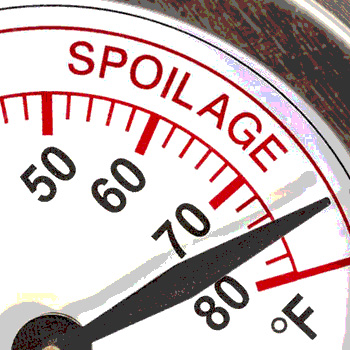Manual HACCP Monitoring – What’s the Worst that Could Happen?

In the early 1990s, a large fast food chain woke up to a public relations nightmare. Hundreds of customers had been infected with Escherichia coli from hamburgers. After spending much of the 1980s growing market share, patrons now avoided the restaurants as if they literally had the plague. Sales plummeted. National expansion plans were shelved. Worst of all, four children died.
This problem still plagues us today. According to FoodSafety.gov, every year, 48 million Americans get sick with food poisoning. Of those, 3,000 will die. Those numbers are staggering for such a preventable problem.
To combat foodborne illnesses, the foodservice industry has standardized Hazard Analysis and Critical Control Points (HACCP), the processes in place that make sure not only that the food is cooked thoroughly but also held at proper temperatures to prevent pathogens from getting into your food. Having been developed years earlier in a coordinated effort by Pillsbury and NASA to make sure the food going to space met the strictest guidelines, these routine process checks have now become standard practice in foodservice everywhere, endorsed by the National Academy of Sciences, National Advisory Committee for Microbiological Criteria for Foods and the Codex Alimentarius Commission. While HACCP regulations are good, the way in which many foodservice establishments maintain their logs is not.
Many kitchens keep track of their HACCP compliance with a notebook or clipboard. Taking and transcribing manual readings leaves lots of room for errors and omissions to cause problems for your customers and your business. Here’s a look at what could go wrong:
Records Get Lost
Oftentimes, HACCP temperature records are kept in a disorganized pile in the manager’s office. While everything undoubtedly has its place, it’s easy to lose something like a small scrap of paper among the piles of receipts, paychecks and whatever else may be lying around. Really, the question isn’t if one day’s worth of records will be lost, but when.
Readings Not Done Correctly
With so much going on in the kitchen, it’s likely that the manager doesn’t have the time to oversee every HACCP temperature reading. That means some of the lesser tasks get delegated to other team members who might not be as proficient in recording HACCP data. Are you willing to bet your restaurant on the fact that your back-of-the-house staff is taking every reading and logging it accurately?
Catastrophic Destruction
A lot of things can happen in a kitchen that could threaten the safety of your paperwork. From fires to floods, once your HACCP readings are destroyed, they’re gone and you’ll have nothing to show when the health inspector comes around.
Pencil Whipping
This is especially troubling. Falling behind on your HACCP temperature readings could cause you to try and estimate what they were. As a result, you may be recalling false readings and submitting them to the U.S. Food and Drug Administration, which would be used against you if someone became ill from the food at your establishment. It’s one thing to misplace or misread HACCP records every now and then but false records that cover yourself at the expense of your customers can make everyone sick.
These risks used to be routine. Now, technology offers a solution to these problems. Automating your HACCP temperature recording process with a system of remote monitors, like Kitchen Brains’® RM-200, maintains tracking of your food and storage temperatures 100 percent of the time. Records are kept digitally and are accessible from the cloud either on premises or from a central location, making it a perfect solution for multi-unit franchises or foodservice locations. Readings are never lost and there’s no loose paper trail if you don’t want one.
Additionally, if temperature readings fall short of your established guidelines, you can be immediately notified to correct the problem, rather than finding out hours or days after a breach happens. That means if a walk-in freezer malfunctions overnight, you can fix the problem before it costs you your entire inventory. Automation ensures the product you’re storing, cooking and serving is a dish worthy of your establishment.
Of course, we’ve gone through what can happen with a manual record of your HACCP temperature compliance. But really, what’s the worst that could happen?
Sick Customers Never Come Back
It just takes one instance of a food borne illness to repel customers from your business, restaurant or franchise for good. Word spreads and soon their friends are avoiding you as well. In the Internet age, every negative experience with a restaurant is amplified by reviews on websites like Yelp as well as through stories on Facebook and Twitter. Depending on the virility of the incident and the influence of the customer, this could result in a major drop in sales.
Really Sick Customers Seek Legal Action
If a customer has to incur any medical expenses due to sickness contracted at your location, you’ll probably end up footing the bill and then some. A disgruntled customer could sue you to cover medical bills, lost wages and general damages. This could total hundreds of thousands of dollars. Before things get out of hand you’ll want to reach a settlement but even that will cost you.
Furthermore, once you’ve had to pay for negligence of any kind, your insurance rates will skyrocket, amounting to thousands more dollars you can expect to pay annually. Interestingly enough, an automated HACCP temperature monitoring system can lower your insurance rates on certain liabilities like inventory spoilage and replenishment.
Really, Really Sick Customers Can Kill Your Business
As in the opening example, this is the worst case scenario. If one or a group of people happens to get extremely sick from your food, due to undercooked or improperly stored food at your restaurant, you can make going-out-of-business arrangements. Once the media gets a hold of the story, customers will stay far away if the health inspector doesn’t shut you down first. The only people coming through your doors will be lawyers seeking to recoup damages. This nightmare scenario leaves staff jobless and proprietors in debt without a business, all of which could have been avoided with proper HACCP temperature and safety checks.
It may seem farfetched but it has happened before and it will happen again. Thankfully, technology makes it easier to avoid becoming the case example people point to when they say, “We don’t want that to happen to us!” Before a catastrophe changes the way the industry does business, keep your kitchen ahead of the curve with a remote monitoring system like Kitchen Brains’ RM-200 which allows you to wirelessly sense, collect, record and alert critical temperatures related to your business. It could save your customers’ lives and your livelihood while reducing your liability.
Edward Musial, certified foodservice professional, is currently vice president of OEM business development at Kitchen Brains. His responsibilities include sales management, new product introduction, product and project management, technical services and key retail and OEM account management. He also has a background in electronics and electrical engineering, with patent applications focused in foodservice technology currently pending.
Christian Koether is vice president of business development. Prior to joining Kitchen Brains, he held various sales positions with Nestlé USA and Nestlé Purina PetCare Company. In 2007, he obtained his M.B.A. from the Tuck School of Business at Dartmouth and is now managing the global implementation of this HACCP-friendly solution with one of the QSR industry’s leading companies.
Looking for a reprint of this article?
From high-res PDFs to custom plaques, order your copy today!




